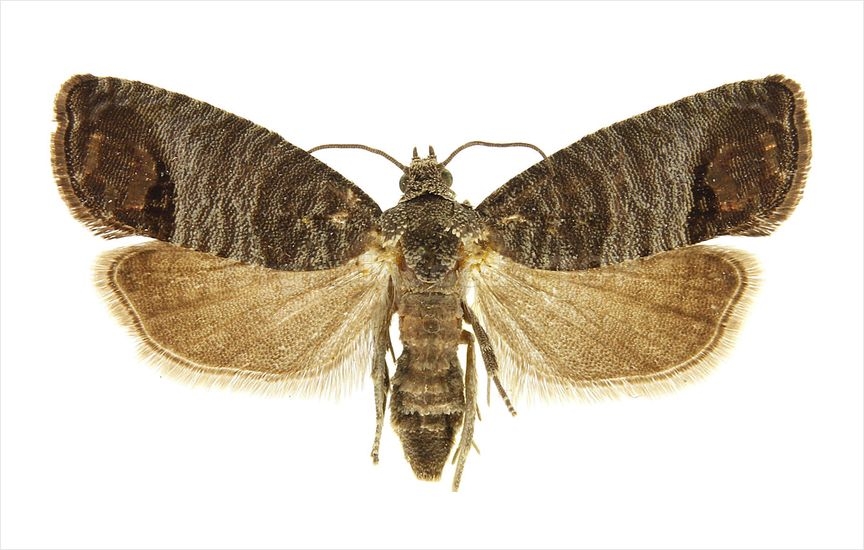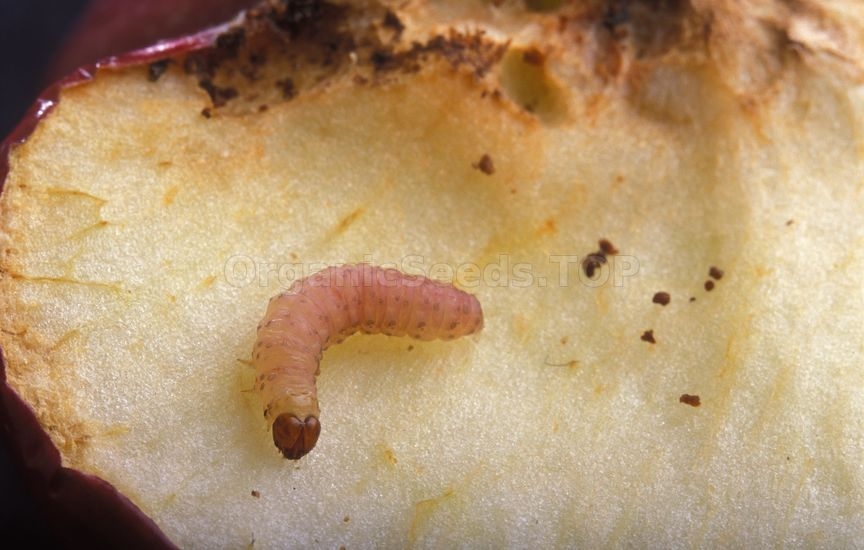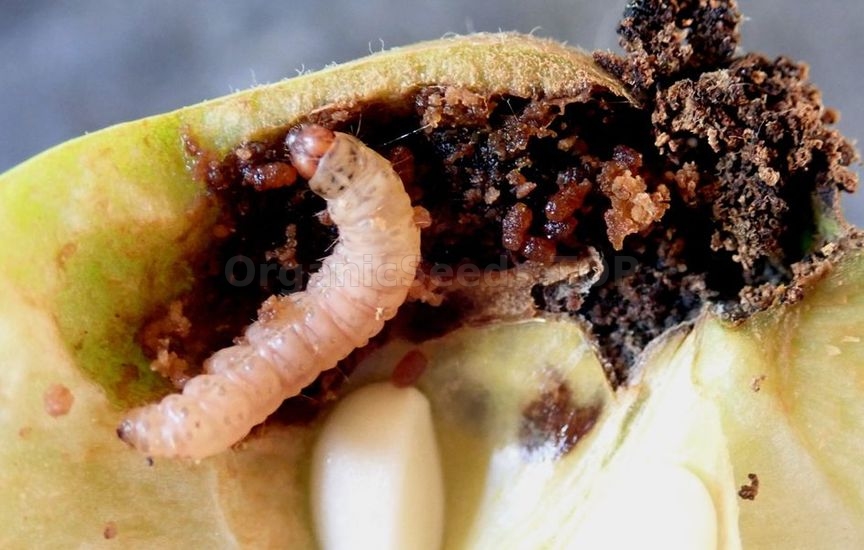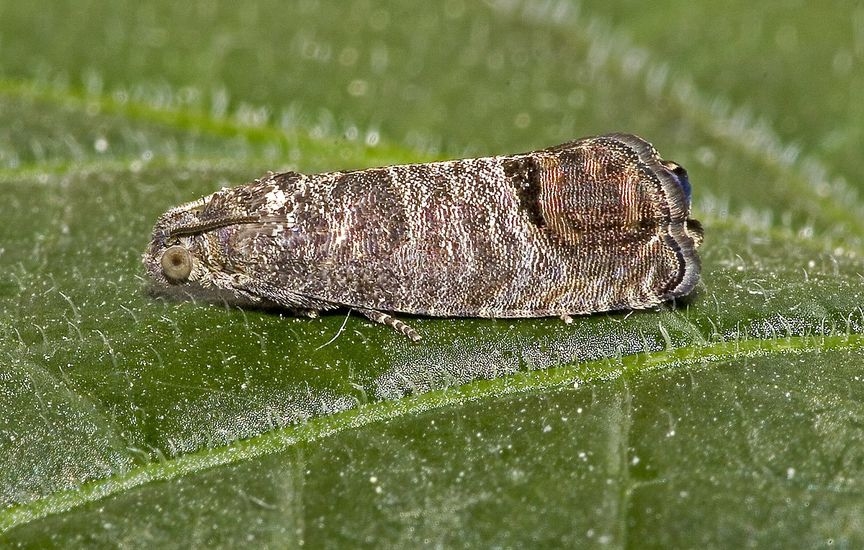Codling moth - «Cydia pomonella» |
 The codling moth is the most common and well-known pest of orchards. The pest's larvae damage apple, pear, peach, apricot, and plum trees; a special form develops on walnuts. Reproduction is bisexual. The last instar caterpillars overwinter in a dense cocoon. The number of generations per year depends on the climate of the location. MorphologyImago
The butterfly is dark gray. The wingspan is 18-20 mm, body length is 10 mm. The forewings are dark gray with transverse dark stripes and a large, oval, yellowish-brown spot with a golden-bronze tint at the apex of the wing. Hind wings with gray fringe along the edges, in a light brown color scheme. When at rest, the wings are folded like a roof. Sexual dimorphism As in all Lepidoptera, the female differs from the male in the structure of the genital organs. In the male genitalia, the lower edge of the VALVO is equipped with a small tooth. In the female genitalia, the duct of the copulatory bursa is 2-3 times narrower than the bursa itself.  Egg The shape is round, slightly flattened. Diameter up to 1 mm. Translucent, shiny, greenish-white. Larva It grows to 18-20 mm in length. The color is flesh-pink on the back and sides, and yellowish-white below. The head and anterior chest shield are brown, with a marbled pattern. The anal shield is weakly colored. At the base of the body's chaetae are large light brown scutes. The abdominal legs are equipped with a single-tier crown of 25-35 claws, the anal legs are equipped with 15-25 claws in the medial horseshoe. The anal ridge is absent. Pupa Length 8-12 mm. The color of the cover is light brown with a golden tint. At the end of the abdomen there is a rounded cone with eight hook-shaped setae. DevelopmentImago
The butterfly season begins simultaneously with the blossoming of the apple tree. Its maximum density is observed after 2-3 weeks, simultaneously with the formation of the ovary; at the beginning the sum of effective temperatures (above 10°C) is 90-110°, and for mass summer the sum of effective temperatures is 150-170°. The years of butterflies are extended and last 1.5-2 months. Insects are most active in the evening, from about 19 to 24 hours. Female codling moths need additional nutrition or at least drip moisture. The first generation adult appears at the end of flowering of pome-bearing species. The development zone of two complete generations is characterized by the annual sum of effective temperatures (above 10 ° C) from 1400 °. The years of second generation butterflies are also extended by 1.5-2 months. Mating period The mating period of the first generation is extended. The female lays eggs one at a time on the lower and upper sides of the leaf blade, the bark of young shoots and branches, as well as on fruits, preferring smooth surfaces. Fertility is 60-120, maximum 180 eggs. According to other sources, maximum fertility can reach 220 eggs. Egg laying is observed during twilight and evening hours at an ambient temperature of at least + 16°C. Egg Embryo development lasts 5-11 days. The revival of the first generation caterpillars begins at a sum of effective temperatures of approximately 230° - usually 17-19 days after the end of the flowering period of late apple tree varieties. At + 27-30°C, embryo development takes 5-6 days, at + 18-21°C - 9-10 days. In the first generation, the egg usually develops in 9-11 days, in the second - 5-7 days. All the above figures are approximate. The exact timing of the caterpillars' rebirth is determined by directly observing the development of the eggs.  Larva After rebirth, the larva (caterpillar) moves to the fruit, entwines it with a web and selects the most vulnerable places for penetration. After some time - from a few minutes to an hour and a half - it bites into the flesh. Having delved into it to the length of the body, the larva turns its head towards the entrance hole and closes it with a plug of cores and cobwebs. The caterpillar feeds under the skin of the fruit for two or three days, then makes a small chamber and molts in it for the first time. Then she gnaws the passage to the seed chamber and molts a second time, then gnaws into the seed chamber and molts a third time. At the fourth instar, the caterpillar makes its way to the surface of the fruit; sometimes it emerges from it and crawls onto the neighboring fruit. After the fourth molt, the caterpillar's nutrition ends and it leaves the crown. The duration of the entire feeding period ranges from 22 days in the south of the range to 45 days in the north. During this time, each larva can damage 1-2 fruits. Adult caterpillars overwinter in dense silky cocoons on trunks in cracks in the bark, as well as in the soil at a depth of up to 3 cm. They choose places for overwintering in the soil mainly at the root collar, as well as on the surface of the earth under debris and plant debris. Pupa In the spring, simultaneously with the beginning of flowering of pomegrass, at a temperature of 8-9°C, the caterpillars begin to pupate, and at the end of flowering, the development of the pupa ends. The emergence of butterflies begins after 2-3 weeks. Abiotic factorsIn the regions of Polesie and the Carpathian region, most of the first generation caterpillars go to wintering areas, where they survive the winter period in a state of diapause. 10-15% of the population pupate and develop into second generation butterflies. In Transcarpathia and the forest-steppe, 30-40% of caterpillars pupate, and in the steppe zone and mountainous regions of Crimea - 50-70%. Butterflies of the second generation fly out before the first generation finishes. As a result, one can observe the simultaneous development of all stages of the pest - from the moment the first generation caterpillars revive (from late May to early June) until the second generation butterflies finish laying eggs (late August).
 The number of caterpillars in a state of diapause in all climatic zones increases sharply by the end of July. By mid-August, pupation completely stops even in the southern regions, which is explained by a decrease in daylight hours. The codling moth is the most common and well-known pest of orchards. At the larval (caterpillar) stage it damages apple, pear, apricot, peach, quince, plum, and walnut trees. Damaged fruits appear prematurely ripe and generally fall off, often accompanied by caterpillars. The economic threshold of harmfulness for the codling moth is set in the end of flowering phase before the formation of the ovaries of the host plant in the amount of damage to 10% of the ovary. Again, in the fruit formation phase, the economic threshold of harmfulness is noted when 2-5 eggs are detected per 100 fruits or 2-3% of fruits are damaged.
You may need:«Codling moth» trapGlue trap (single adhesive cardboard) 205x125 mmPheromone traps |
|
|
